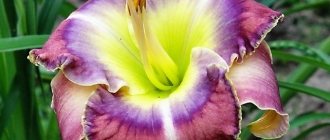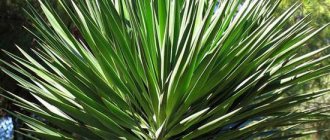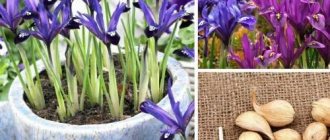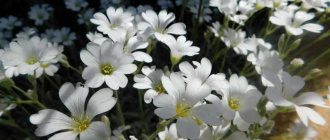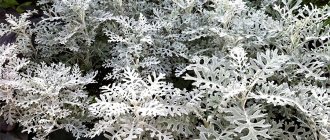Iris plant: description
This is a perennial and unique herbaceous plant with a strong rhizome. There are two types of shoots: vegetative and generative. Thin leaves with a waxy coating are united by fan-shaped bunches at the base of the peduncles.
Some varieties have no stem leaves or very few of them. Single flowers are located in inflorescences; they have a unique aroma and elegant shape. There is a huge palette of shades from snow-white to dark purple. Large and beautiful flowers are made up of six petal-shaped lobes. The three outer lobes tend to slope slightly downward.
9.Varieties of irises:
All irises can be divided into bulbous and rhizomatous.
9.1. Siberian iris, or iris - Iris sibirica
Perhaps the hardiest, tallest herbaceous plants among rhizomatous irises, reaching a height of 0.5 - 1 m. They have green, hard and very narrow leaves with parallel venation and rounded erect stems. The length of the leaf blades can reach 40 - 80 cm. At the top of the shoots at the beginning of summer, attractive flowers appear in shades of blue, purple, yellow, burgundy, brown or orange. Siberian iris is characterized by high frost resistance and rapid growth.
↑ Up,

9.2. Bearded iris
This is a large group of tall, hybrid, rhizomatous plants based on the German iris, the main distinguishing feature of which is the presence of a “beard” - a narrow fluffy strip at the base of the flower petals.
↑ Up,

9.3. Bulbous irises
Miniature, low-growing plants with narrow, green leaves, these irises are now often purchased from Holland. They are distinguished by very large flowers compared to the size of the plant itself, which can bloom simultaneously with such primroses as primrose or crocus. The color scheme is varied and includes yellow, white, lavender, blue, burgundy and purple shades.
↑ Up,
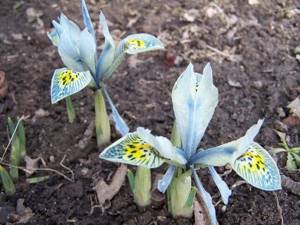
9.4.Iris reticulum
Bulbous irises also include the reticulated iris - dwarf, spring-flowering plants, not exceeding 15 cm in height. Bulbous varieties are most suitable for forcing at home.
9.5.German iris -Iris germanica
Quite large rhizomatous plants 30 - 60 cm high with sword-shaped green leaves and large, often fragrant flowers. Each peduncle can bear up to 6 flowers of a very diverse range of colors. Nowadays there are varieties with flowers painted in several shades at once. The German iris does not have bulbs, but reproduces using large creeping rhizomes.
↑ Up,
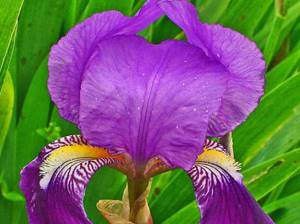
9.6. Swamp iris, false calamus or yellow - Iris pseudacorus
Large rhizomatous plants, reaching 120 - 150 cm in height, form large clusters with age. The leaves are xiphoid, dark green. Peduncles bear from 4 to 12 bright yellow flowers at the tops. Flower petals often have darker brown speckles.
↑ Up,
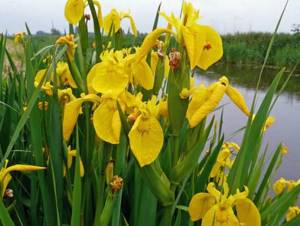
Iris plant: characteristics and description of varieties
Iris boasts a variety of colors and long flowering times. Popular varieties:
- Bearded is the most popular among garden irises. On the outer petals at the base there are stripes of hairs, which are very noticeable against the general background. There are low-growing, medium-growing and large-growing plants. Height reaches 70 cm.
- The Siberian iris plant is distributed from the north of Italy to Lake Baikal. This species is also found in the Caucasus, Turkey and the Komi Republic. There are several huge leaves on the branched stem. Magnificent flowers are located on stalks. Light gray seeds were hidden in the box.
- Dwarf is common in arid grass steppes. In addition, it can be found on limestone slopes and sands. The iris reaches a height of no more than 15 cm. The leaves are bluish in color. The peduncle is approximately 3 cm high; the plant begins to bloom in May. Tolerates lack of moisture very well.
- Dutch has a special underground organ instead of a rhizome, which contains reserves of nutrients. The stem has dense, narrowly grooved leaves. The peduncle grows on average 80 cm. The flower can be one-color or two-tone. This variety is very heat-loving and in winter needs protection from wind and cold.
- The marsh iris plant has attractive bright yellow flowers, decorated with gnarled streaks. Blooms from early May to June. This variety is heat-loving and winter-hardy, loves direct sunlight. In the wild it grows mainly near river floodplains and the banks of reservoirs. It can be seen in Europe, China and the Far East.
- Ensiform is considered a late-flowering variety. The leaves are not wide and do not exceed 40 cm in height. The flowers are flat with small inner and wide outer petals. The height of the peduncle is approximately 70 cm. It begins to bloom in mid-summer and blooms until the end of August.
Brief characteristics of the iris plant:
Bearded irises get their name from their colored hairs located on the outer perianth lobes. The hairs resemble a beard in appearance.
Siberian varieties are distinguished by their unpretentiousness and resistance to frost. In addition, cut leaves have decorative value.
Japanese irises can be divided only after five to seven years, since they retain their decorative properties and productivity for a longer time. In early spring or autumn, division of this species is carried out.
There are three groups of irises:
- low-growing - the height of the peduncle is 20–35 cm;
- medium-sized - peduncle from 35 to 70 cm;
- tall - peduncle more than 70 cm.
Garden irises: types and varieties
Types of cacti: plant options without spines or with leaves
Irises are loved because they have an amazing appearance when they bloom. The second name of the flower is iris, as it is from the genus iris. Garden species include the following groups of irises:
- bearded;
- Japanese;
- dwarf;
- Siberian
Bearded species can often be found in flowerbeds and gardens. They are frost-resistant and do not need shelter in winter. The plant is resistant to diseases and pests.
Bearded irises
Well-known varieties are:
- Supreme Sultan is the tallest among the bearded beauties, reaching up to 100 cm. The upper petals are dark yellow, the lower velvety mahogany colors. The iris blooms from June to July;
- Sultan Palace. The buds of the German iris are large in size, the petals are dark red in color. Blooms from May to June;
- Visir. The flower is large, round, with a magnificent ruffled crimson-garnet hue with red beards. Grows up to 95 cm;
- Champagne Waltz. The height of the flower is 92 cm. The foliage is white with an apricot-yellow corrugated border and red beards.
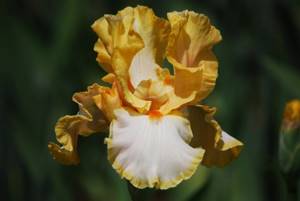
Champagne Waltz
Dwarf varieties
Small iris is a real find for flower beds and lawns. Its size is no higher than 40 cm. Popular varieties of dwarfs:
- Tinker Bell grows up to 15 cm. The basal leaves are broad-linear and bluish. The bud is yellow or purple in color. Blooms in May;
- Puppet Baby is an elegant flower with a blue tint. It has a lilac-brown coloring at the base of the fouls and copper veining. Height 18 cm;
- Sapphire Gem captivates with bright sapphire blue petals with a light blue beard;
- Dark Over is a gorgeous large flower of a dark burgundy hue with a copper-yellow beard at the base of the lower petals.
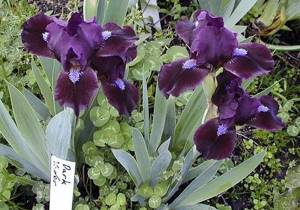
Dark Over
Bulbous irises
Bulbous species can be grown both in open ground and in a flowerpot indoors. There are about 800 varieties. Among them the most popular are:
- Alida is a frost-resistant type. Blooms as soon as the snow melts. The buds are soft blue with yellow and white markings. Does not exceed 10-15 cm;
- Katharine Hodkin belongs to the reticulated varieties. The upper petals are lilac, the lower ones look like the feather of an exotic bird with purple strokes and a yellow spot;
- Dunford is a dwarf bulbous member of the genus. Thanks to its small size, it has become a favorite in indoor collections. The bud is yellow;
- Pauline is a small plant that is perfect for mixed borders, rock gardens and rockeries. The bud is purple with an intact white spot. Blooms immediately after the snow melts.
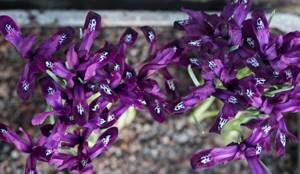
Pauline
Note! In order for beautiful flowers to appear on the site, it is necessary to carefully select the bulbs before planting.
Siberian species
Specific Siberian varieties are distinguished by a hollow stem and triangular-shaped buds. The plant is small in height, up to 40 cm, blooms for a month. The best representatives of the species include:
- Alba is a beautifully flowering ornamental shrub up to 45 cm. The bud is a soft snow-white color. The stem has long sword-shaped leaves;
- Big Ben is a huge evergreen shrub with long, pointed leaves. Blooms in early spring. The inflorescence is pale lavender;
- Super Ego. It does not have many brothers of similar colors. The color of the iris changes from one shade of blue to another;
- Double Standard. The flower has a violet-lilac color with a rich yellow center, along which stripes are painted as if with a brush.
Siberian varieties are resistant to temperature changes and are unpretentious in care
Japanese irises
The petals of Japanese iris are arranged horizontally. Breeders specifically bred this species for humid climates. They are perfect for growing near ponds and require frequent watering.
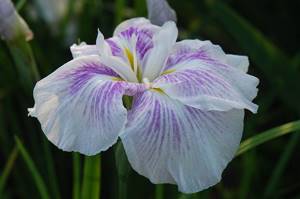
Iris ensiform Kogesho
The best varieties of this type of iris flower include:
- Lilac Haze grows up to 85 cm. The bud is double, the petals do not overlap each other. They are light lilac in color with purple rays;
- Kogesho is a herbaceous plant up to 1 m. The bud is 20 cm in diameter. The iris is large, white in color with purple streaks in the center and small yellow spots. Has a short flowering period, up to a month;
- Vasily Alferov. Iris was bred in Russia and is a frost-resistant species. Inflorescence of rich purple color. The petals are velvety with bright golden-yellow eyes. It blooms at the end of June for 20 days.
Important! Excess calcium in the soil has a detrimental effect on all Japanese varieties.
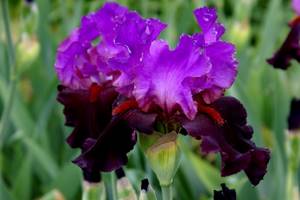
Iris neglet Romantic evening
Common iris
Ordinary killer whales are not demanding on soil composition, they are frost-resistant and drought-resistant. If there is too much moisture in the soil, the roots will rot. It is not recommended to plant them on heavy clay soils. The common iris grows quickly and requires frequent weeding and loosening of the soil.
Peculiarities
Depending on the type, the iris plant (planting and care of which is described below) also has different root systems. They are thin, fibrous, fleshy and few-branched. The leaves are usually xiphoid, with a waxy coating, and green in color. The condition of the flower can be determined by its bloom. An even layer means that the iris does not get sick. The leaves retain their decorative appearance until the beginning of autumn. The flowers are large, of various colors (blue, white, blue, pink, etc.). Several shades of flowers can be on one corolla, but a single color is not uncommon.
Who do they give irises to?
Irises have not left the flower Olympus since ancient times. Florists use them to create gift bouquets for various special occasions:
- Newlyweds collect arrangements of white flowers for their wedding. It is believed that this will help preserve the love between spouses for a long time.
- It is appropriate to give bouquets of irises of different colors to loved ones and relatives for birthdays. It is important what meaning the giver will put into this gift. Irises are able to “read” feelings and thoughts and transmit energy to others.
- Compositions containing dark blue irises are appropriate as a gift for a man of any age and status. You can add a gift to the bouquet in the form of expensive alcohol and dark chocolate.
- At official events, compositions with the inclusion of dark purple flowers in packaging made from expensive natural materials look impressive.
Irises are valued in floristry because they can be included in bouquets for both sexes and given as a gift for any occasion.
What flowers go with irises?
Irises look equally magnificent not only in a monogamous bouquet, but also in combination with other flowers. The most successful options are:
- irises and tulips;
- irises and roses;
- chrysanthemums and roses and irises;
- irises and lilies;
- irises and alstroemeria.
In bouquets, you can also use wildflowers in strictly dosed quantities so that the composition does not look sloppy. Irises can act as a central or auxiliary element of a bouquet.
Growing
Japanese irises love warm weather, so if they are bred in northern regions, they grow well and bloom mainly indoors. Siberian varieties are frost-resistant, and bearded irises are less demanding than the two above-mentioned species.
Cultivation of plants requires drained, fertile and moist soil. Excess moisture is removed. When planting a plant in heavy soils, it is recommended to add garden soil, sand or special fertilizers. Top dressing is applied at the rate of half a ten-liter bucket per 1 m2. If soil neutralization is needed, bone meal is used; Siberian irises do not like lime.
Planting, care and cultivation of irises
Most often, irises are planted either in spring or autumn. Experts recommend dividing and replanting irises as soon as they bloom. This must be done so that the plant has time to take root before frost.
In order for irises to bloom magnificently, they need to be replanted every 3-4 years. Siberian irises require replanting once every ten years.

Bearded irises are more capricious. For good growth and flowering, it is recommended to fulfill the following important conditions:
- Place the plant in a well-lit place.
- Protect from drafts.
- It should be planted on a hill so that there is an outflow of melt water.
- Ensure good drainage.
- For fertilizer use potassium-phosphorus fertilizers.
- Treat the soil with herbicides to kill weeds.
- It is not recommended to fertilize the soil with manure.
- Add chalk or wood ash to acidic soil.
- Add clay soil to sandy soil.
- Add peat and sand to the loam.
Planting flowers in spring
First of all, holes are prepared for planting seedlings. Bearded irises are planted in the sand in a shallow hole. The rhizome is laid out horizontally and covered with earth so that the upper part remains above the level. If the root system is completely covered with soil, the process of decay may begin. Water generously.
Beardless species are buried several centimeters deep. Additionally, it is recommended to mulch with peat or fallen pine needles. The distance between the holes should be at least one and a half meters.
Before planting, it is necessary to examine the seedling. Rotten roots should be removed. It is also recommended to shorten long roots. Be sure to disinfect the root system in a solution of potassium manganese and treat it with growth stimulants.

Autumn planting
Autumn planting of irises follows the same rules as spring planting. Recommended time: August-September. Although experts believe that the earlier you plant or replant, the greater the chance for the plant to take root and get stronger before the coming winter.
Use a pitchfork to dig up a bush, divide it into one-year-old sections with a leaf blade, shorten, clean and treat the root system in the same way as during spring planting. Before planting in the fall, gardeners recommend drying the bush for several hours in the sun.
When preparing the holes, the growth of the seedling is taken into account. For low plants, a distance of 15 cm is recommended, for iris of medium height - 20 cm, and for tall ones - 50 cm.
Caring for irises
Watering
Irises are those plants that love warmth and light. You need to be very careful with watering, especially during the formation of buds. During this important time, there should be enough water and it should be supplied regularly. The rest of the time, it is recommended to water irises as needed.
Top dressing
The main rule is that it is forbidden to fertilize irises during flowering. But basically, for good growth, plants receive a sufficient amount of nutrition during the preparation of the land in the spring. If for some reason there is a need to feed the iris, then potassium-phosphorus fertilizers are used for this purpose. They are applied at the root during growth.
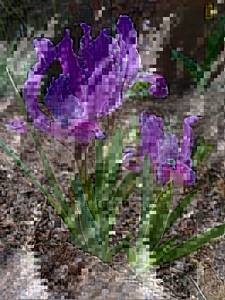
Weed control
Weed control requires great care. Since the root system develops horizontally and is very close to the surface, you only need to destroy weeds with your hands. To allow air to reach the roots, it is necessary to loosen the soil. This must be done very carefully.
To protect your pet from pests, it is necessary to remove wilted flowers. Often, this is a breeding ground for pests.
Adding Nutrients
During growth and development, the plant requires feeding with inorganic complex fertilizers, which include potassium, phosphorus and nitrogen. Fertilizers are applied three times. The first is as soon as the plant emerges from the soil. The second time - approximately thirty days after the first application of fertilizing. And the last time was when the plant bloomed.
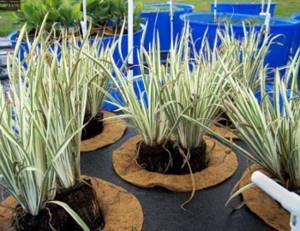
Another method can be used. In the first stage, only nitrogen and phosphorus substances are added. In the second, potassium is added to the previous elements, and in the third place, only potassium and phosphorus fertilizers are added. During the growing season, nine grams of the above fertilizers should be applied per square meter. Fertilizer is added exclusively in liquid form.
New varieties of irises
Every year, breeders develop new varieties that differ in color, height, winter hardiness and other characteristics. Some of them are quickly gaining popularity.
Medici Prince
A tall bearded iris, whose name translates as “royally rich.” The petals are coral, pink, and turn into a rich burgundy. Each Prince Medici bush produces 8–10 inflorescences, but there can be more.
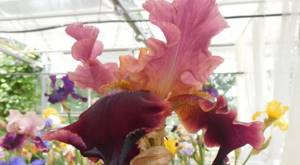
The spectacular Medici Prince variety looks beautiful both in the garden and as a cut flower.
Torero
Toreador is another tall bearded iris with apricot-orange upper petals and strawberry-red lower petals. This variety will appeal to lovers of pastel shades.
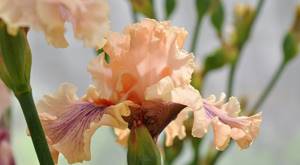
Torero – a pleasant flower with delicate colors
Magical Glow
Magic Glow is another tall variety. Peduncles reach 100 cm. Up to 9 buds are formed on each bush. The petals are flaming orange, the beard is red. The iris blooms in mid-summer.
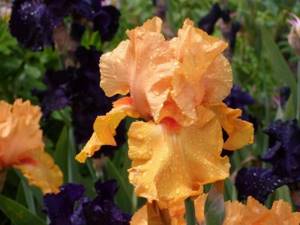
The bright orange inflorescences of Magic Glow are ideally combined with dark lilac and rich blue shades
Cherry Blossom Song
Song of cherry blossoms is a very spectacular variety of tall iris (up to 90 cm). The upper petals are soft pink, the lower ones are cherry, with a purple tint.
Read more Caring for irises in autumn and preparing for winter
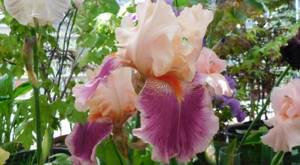
Each Cherry Blossom Song plant produces 7–9 buds; flowering begins in mid-July
Reproduction
Work on dividing the roots is carried out at the end of the summer or at the beginning of autumn, after about four years of the plant growing in one place. If this operation is not carried out, the iris will not bloom, since four years after planting the flower buds stop forming. For this reason, to obtain abundant flowering, the roots should be divided or their upper part removed.

One of the simple methods of dividing rhizomes is the formation of annual links with a bunch of leaves. Each link is divided into separate pieces with buds. After cutting, they are left in a dry, warm room for 48 hours, during which time the sections form protective wound tissue. In addition, the cuts can be sprinkled with crushed coal.
The seedlings are placed in containers and stored indoors, as rooting occurs in winter. Rhizomes dug up in the fall should be stored in a cool, dry place. When planting roots in spring, they are cut to 8–10 cm in advance, and by two-thirds in autumn or summer.
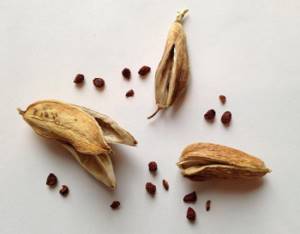
Replanting after 4–5 years is quite a long time, so the plant can be propagated by seeds. Each variety has its own characteristics. Siberian and Japanese irises can be grown from seeds without any problems, but bearded irises are a little more difficult, since their seeds have a thick cover, and seedlings appear in the second or third year. Scientists believe that propagation by seeds is best used in selection, since this method does not guarantee good plant growth.
The best varieties of re-blooming irises
Repeat-blooming irises produce flowers both at the beginning and at the end of summer: the second wave occurs at the end of August and the first half of September (if the autumn is warm enough). These are decorative, bright varieties that delight with pleasant flowers twice a season (subject to watering and fertilizing). The most beautiful varieties of re-blooming irises with photographs and names will help when planning your flowerbed design.
Immortality
Immortality is a tall variety (up to 75 cm). It blooms for the first time in early summer and forms inflorescences again in September. Belongs to the group of bearded irises, grows for many years, while the growth rate is small. Requires good lighting, but easily tolerates short-term partial shade.
Read more Siberian irises: description of plants, flowering time, best varieties
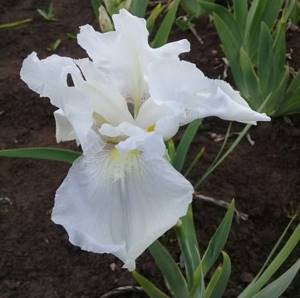
Snow-white Immortality inflorescences fit into the design of any flower bed
Jennifer Rebecca
Jennifer Rebecca is an iris variety that blooms in June and September, and in the southern regions even in October if the autumn is warm. Prefers well-lit, moist soils. It belongs to the tall varieties: it reaches a height of 85 cm.
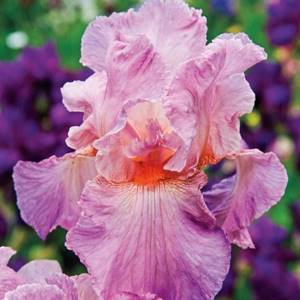
Pastel pink inflorescences of Jennifer Rebecca look good against the dark lilac background of other varieties
Attention! The variety is winter-hardy and can withstand frosts down to -35 °C. Therefore, it can be grown in most Russian regions.
Bakwit
Buckwheat (Buckwheat) is a tall variety of irises, growing up to 90 cm. It blooms in mid-July and again in September. Refers to varieties of German selection. The lower petals have a light brown edge, forming a beautiful outline, which further enhances the beauty.
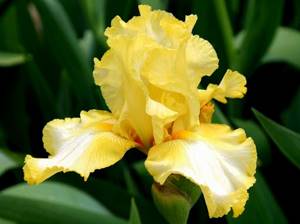
Bright yellow Buckwheat buds appear twice per season
Suga Blues
Sugar Blues is a repeat-blooming, tall variety of iris, reaching a height of 80–90 cm. Prefers well-moistened and lighted places. If fertilized and in good weather, it blooms again in mid-September. Sugar Blues is a variety of German selection, bred in 1985.
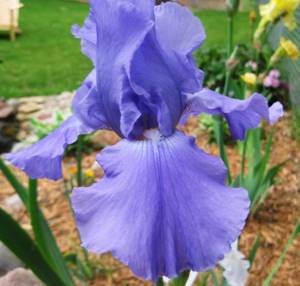
Solid Sugar Blues petals with darker veins combine well with yellow and orange inflorescences
Care
For Siberian and Japanese varieties, soils that are well able to retain moisture are suitable, while for bearded varieties soil with a slightly acidic or neutral environment is suitable. Non-chernozem soil must be fertilized.
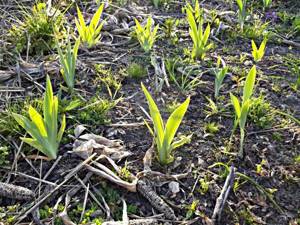
Each type of plant needs a different amount of water. For example, Siberian iris requires constant watering during the flowering period, while bearded iris prefers moderate watering.
It is best to place irises in sunny or semi-shaded areas. If you plant a plant in continuous shade, it will stop flowering. Japanese and bearded species can tolerate severe shade.
Useful properties of the plant
Currently, only a few varieties of the iris plant are acceptable for use in medical practice. For example, Florentine and German. The main raw material is the roots of the plant due to the content of its unique essential oil. Three years after planting the iris, they begin to harvest them. The roots are washed with water, cleared of lateral shoots, and then dried. Store in closed containers.
The roots of irises contain a huge amount of ascorbic acid, starch, sugar and many other equally useful components.
